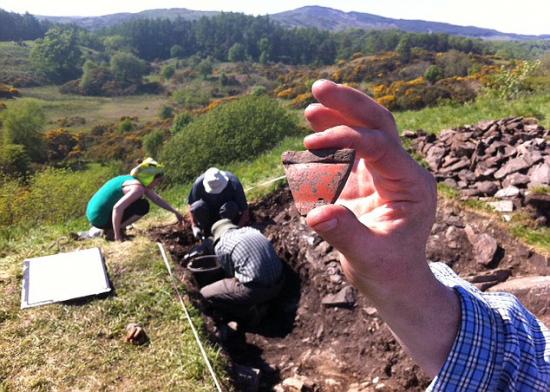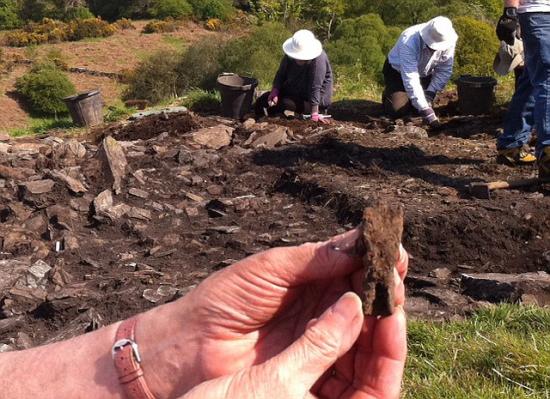Rob Waugh
Source - http://www.dailymail.co.uk/sciencetech/article-2152693/Lost-Kingdom-Scotland--remains-burnt-Dark-Ages-fort-hint-ancient-ALLIANCE-Picts-Britons.html?ito=feeds-newsxml
- 'Lost kingdom' occupied between 5th and 7th century AD
- Shard of African pottery hints at a high-status leader, like a King
- Pictish stones also found
- Was Kingdom an alliance between Britons and Picts?
Pottery from Africa found in a burnt-out fortress in Galloway hints at a 'lost' Dark Ages kingdom that may even have been born of an alliance between Britons and Picts.
Remarkably, a Pictish carved stone at the fort's entrance shows two entwined symbols which could have been evidence of an alliance between Britons and Picts, possibly through a ‘royal’ marriage.
A shard of sixth century pottery from Africa also found at the site shows it could only have been home to someone of ‘the very highest status’, like a King.
The Picts were a savage tribe who lived north of the Firth of Forth - very few Pictish stones have ever been found outside their traditional territory.

A newly found spearhead dates from around that time, while sixth century pottery from Africa shows it could only have been home to someone of ¿the very highest status¿, like a King

Like Mel Gibson's ferocious warriors in Braveheart, the Picts were known for blue body-paint and a rather hostile attitude to southerners
Archaeologists are searching the site to solve the 200-year mystery of the Pictish carving.
The stone has baffled historians because Galloway was inhabited by the tribe known as Britons.
The Britons were a Celtic people who occupied much of Britain - but were fragmented after the Anglo-Saxon settlement in the 5th and 6th centuries AD.
Further north were the Scots, with ‘Pictland’ further still, north of the Firth of Forth.
The Pictish stone is one of only three known out of their traditional territory - the others being in known Dark Age capitals.
Ronan Toolis of Guard Archaeology, who is leading the dig, said today/yesterday that the royal link could finally provide an explanation.
He said: ‘It looks increasingly likely that this fortress was built in the Dark Ages, and occupied during the fifth to the seventh centuries AD.
‘The Pictish stone dates from that time, but the big question has always been what it was doing in Galloway.
‘We know of only two other similar carvings outside Pictland - at Dunadd in Argyll and on Edinburgh Castle rock, both of which were capitals of Dark Age kingdoms.

The Pictish stone is one of very few found outside the tribe's traditional territory north of the Firth of Forth - and hints at a possible alliance between Picts and Britons in the Dark Ages

A spearhead from the burnt-out fort on Trusty's Hill, which archaeologists now think may have been the centre of a lost Dark Ages kingdom
WHO WERE THE PICTS? THE TRIBE WHO HELD OUT IN THE NORTH

Mel Gibson's blue face paint in Braveheart is a nod to the Pictish tradition of body-paint - but the real Picts fought stark naked, and there are records of them doing so up until the 5th Century.
The Roman name for the people - Picti - means 'painted people'. It's not known what they called themselves.
The habit of fighting naked, especially in the cold Scottish climate, didn't harm the tribe's reputation for ferocity.
Picts held the territory north of the Firth of Forth in Scotland - and were one of the reasons even heavily armoured Roman legions could not conquer the area.
It's long been debated how the Picts and their Southern neighbours the Britons interacted with one another. The discoveries in Galloway hint that the two might have allied, at least briefly - before the fort was burnt to the ground.
‘At Trusty's Hill we see a Z-rod and double disc which is a classic Pictish symbol. The other symbol on the stone is a fish monster with a sword, which is unique to this site.
‘It could be that we are seeing an alliance between the Picts and local Britons - two crests coming together, almost like a coat of arms.’
Mr Toolis said the vital find was the African pottery, however.
He said: ‘This pottery shard, which looks like part of the rim of a bowl, is African Red Slip Ware, which came from Carthage and dates to the sixth century AD.
‘It is very rare in British, let alone Scottish Dark Age sites - the early Christian monasteries at Whithorn and Iona being the only other Scottish sites we can think of.
‘It not only indicates that Trusty's Hill was inhabited at the same time as when one would expect the Pictish Carvings to have been made but it means that very high status people in post-Roman Scotland lived here.
‘We might be discovering the evidence to show that Trusty's Hill was a stronghold of the Dark Age Kings of Galloway.
‘It could even be further evidence that the Dark Age Kingdom of Rheged, thought to have been located somewhere between Wales and Ayrshire, may actually have been in Dumfries and Galloway.’
Trusty's Hill was excavated in 1960, when vitrified stone - subjected to intense heat and effectively melted - was first identified.
The fort had clearly been burnt down, possibly at the hands of a Northumbrian enemy.
Mr Toolis said: ‘The fort was captured and destroyed. It would have burned in spectacular fashion, and the flames would have been seen miles away for days.
‘One known enemy of this area, who existed around the same time, was the Northumbrian known as Flamddyn, or Flame Bringer, which would certainly be an appropriate name.’